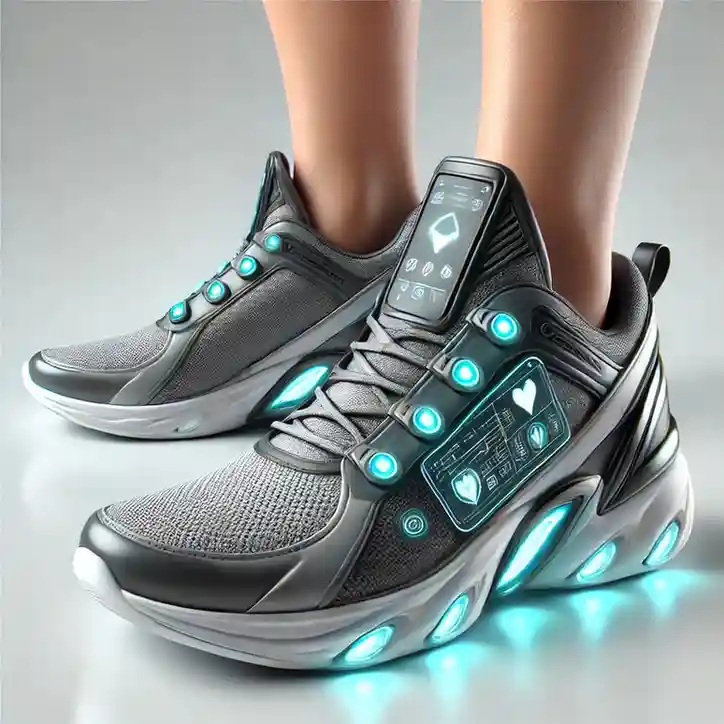As an extension of wearable technology, innovative smart shoes have—in some ways—gone beyond traditional performance and comfort to add fitness tracking, navigation features, and personal preference settings. The boots have sensors, wireless connectivity, and apps that provide users with a better and more interactive experience. This article will discuss the ‘Pros and Cons of Smart Shoes’ before looking at consumer reviews and then drill down into ‘Smart Shoes Technology.’

Table of Contents
What are smart shoes?
Smart shoes make a move towards the foot introduction of technology that will augment what the user is experiencing. These shoes have added features like GPS, activity tracking, and health monitoring. This type of shoe technology comes with sensors, Bluetooth, and mobile apps to collect and analyze data, making it perfect for fitness enthusiasts, athletes, and anyone looking to make life easier.
Functional Features of Smart Shoe
- Fitness Tracking: Smart shoes record steps, measure distance, and even count calories burned.
- Health Monitoring: High-end models also monitor heart rate, posture, and gait.
- Healthcare-come: Navigation: GPS-enabled smart shoes guide the user with vibrations to reach a destination.
- Customizable Comfort: Such smart shoes also have adjustable insoles and temperature control.
- Data Synchronization: The collected data is compatible with mobile apps for detailed insights.
Smart Shoes Advantages
1. Better accountability
Tracking smart shoes provides users with accurate measurements to track their daily steps, distance, and calories. This should be of interest to users who are passionate about fitness.
2. Health monitoring
Health-focused Smart shoe technology can measure physical parameters such as heart rate and posture. These shoes prove to be beneficial for individuals or those recovering from injuries or suffering from chronic diseases.
3. Ease of Use and Navigation
The GPS connections made by digital shoes have made it easy for users to find their location. Vibrations are used to cue for direction when walking outdoors or in an unknown area.
4. Individual comfort
Thus, the smart shoe also comes with adjustable insoles that allow users to customize it according to their needs, as it controls the temperature. It makes the smart and digital shoes more comfortable to wear for long periods.
5. Insights into data
Data collected through smart and digital shoes can be analyzed through apps, giving users insight into their fitness progress and health metrics.

Smart Shoes Disadvantages
1. Expensive
Smart shoes are more expensive than regular shoes because of the advanced technology used in them, making their budget a barrier for buyers.
2. Battery life
Most digital shoes are made to work entirely with the use of batteries. Thus, charging them frequently can be a great inconvenience for users.
3. Durability issues
Using a lot of technology in a shoe will reduce its durability. Talking about water exposure and resistance to wear and tear is prominent.
4. Complexity for non-technical people
Some people find the Smart shoe technology so complicated that they can hardly use it; this is especially true for non-techies who do not know how to sync data or run other apps.
5. Privacy and data security
Data collection through smart shoes can bring privacy and security concerns, and more user information needs to be securely secured.
Smart Shoes Reviews
To provide an all-rounded view, we put together user reviews to show real-world experiences concerning smart and digital shoes:
Good Reviews
- Fitness Buffs: Many people find that digital shoes track activity and provide accurate health insights.
- Travelers: Praise is given for GPS-enabled navigation for travel and hiking.
- Fans of Customized Comfort: Adaptable comfort features seem to have an approval rating, especially among those with distinct footwear needs.
Top 10 Best Weird Shoes For Men And Women
Negative Reviews
- Battery Life Concern: The major complaint among most users was the regular need for charging.
- Durability Issues: Many reviewers are complaining about the poor water resistance and wear and tear from day-to-day use.
- Price Issues: Digital shoes were considered expensive by most would-be buyers and therefore were avoided.
The Future of Smart Shoes Technology
The design and development of Smart shoe technology are advancing rapidly. The new models are expected to feature:
- Better Battery Life: The long battery life will eliminate the perfect barriers of concern for users.
- Advanced Health Monitoring: Blood pressure measuring and fall detection are further possibilities.
- Eco-Friendly Materials: Prospective manufacturers may use recyclable, eco-friendly materials in their products.
- Connect with other Smart Home Devices: Seamless connection with other smart devices is most likely an improvement.

Final Thoughts
If you could name a pair of shoes, they would be Smart and digital. Such footwear changes the way a person interacts with their footwear. Shoes with special features offer the following benefits to the wearer – fitness tracking, health monitoring, and even providing individual customizations. However, all these good things come with quite a few costs, such as high prices, limited battery life, issues of durability, and so on. Critiques would be the reviews from actual people that give a fair insight into how these shoes fit into real-world applications and their problems.
Today’s Smart shoe technology is bound to change upwards as improvements become possible. However, incorporating such changes or modifications will make the technology available to a much wider and more diverse audience. Tech-savvy, fitness enthusiasts, and all those looking for innovations in footwear technology will enjoy this exceptionally versatile combination of style and functionality offered by modern shoes.


